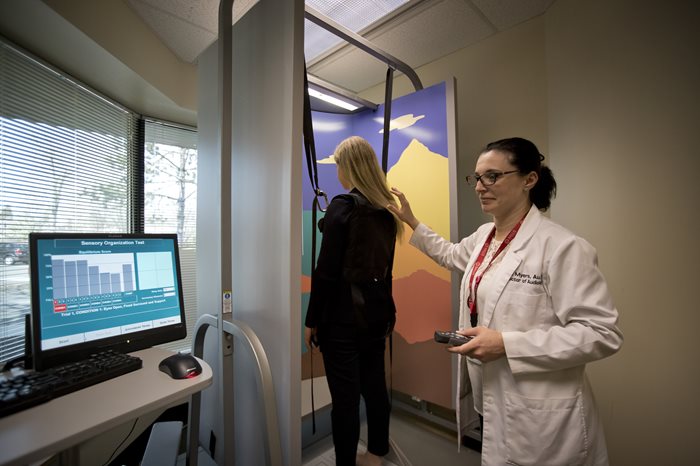
The complex nature of the vestibular and balance systems require diagnostic measures that go beyond the measurement of simple movement. Vestibular and balance evaluations at the Pennsylvania Ear Institute provide a comprehensive view of the vestibular, visual, postural, and neurologic systems which contribute to our equilibrium. A problem in any one of these systems can lead to symptoms such as true spinning sensations (vertigo), imbalance or unsteadiness, falls, lightheadedness, “wooziness” or “dizziness.”
Vestibular and Balance Evaluations:
- Videonystagmography
- Rotational Chair Analysis
- Dynamic Visual Acuity
- Computer Dynamic Posturography
- Video Head Impulse Testing
- Vestibular Evoked Myogenic Potentials
What is a Vestibular Disorder?
The vestibular systems in our inner ears are constantly working through a series of fluid filled canals and hair cells that help us detect motion. In fact, they work so well most of the time we are not even aware that they exist. However, when one or both systems stop working correctly people can develop serious symptoms including unsteadiness, “dizziness” or have the sensation of movement, spinning or floating.
There are many types of vestibular disorders. A person’s case history and a good description of exactly what types of symptoms the person is experiencing in conjunction with diagnostic testing can often identify where in the system the person may be having a disorder. This is important because knowing what is causing the symptoms can lead to better management strategies.
The inner ear vestibular system works with other systems in our body, such as the visual (eyes), and skeletal (bones/joints) systems to maintain the body's position. These three systems, along with the brain and nervous system can be a source of balance problems.
What Are Some Common Vestibular Disorders?
- Benign Paroxysmal Positional Vertigo (BPPV):
- This happens when small calcium crystals (otoconia) become dislodged and trapped in one of the balance canals. Symptoms often include brief but intense spinning sensations whenever a person bends down or rolls onto one side.
- Vestibular Neuritis/Labyrinthitis:
- This happens when a virus enters the inner ear and causes one ear to stop working. Symptoms often include one severe attack of true rotational vertigo that last for several hours or days which is then followed by a few weeks of general imbalance with improvement over time.
- Bilateral Hypofunction:
- This happens when both vestibular systems stop functioning or experience a reduction in performance. Symptoms include trouble walking on uneven surfaces or in the dark, or blurry vision with head function.
What Else Can Cause Symptoms of Dizziness, Imbalance or Falls?
- Cardiovascular health
- Vision
- Motor Control/Muscle Weakness
- Certain Medications
- Diet
- Low/High Blood Sugar
- Anxiety
Comprehensive Testing
Videonystagmography (VNG)
This is the most common test used to evaluate the vestibular system (the balance portions of the inner ear). The vestibulo-ocular reflex (VOR) is a reflex between the vestibular system and the eye muscles that keeps our vision in focus as we move our head. This reflex allows eye movements to be used to evaluate the vestibular system. The patient wears goggles with infrared cameras that record their eye movements while watching lights, in different head and body positions, and when warm and cool water are introduced into the ear canals. The results can identify vestibular dysfunction, as well as central nervous system pathology so that appropriate recommendations can be made.
Rotary Chair
This test allows us to evaluate the vestibular system at natural head speeds. The patient sits in a computer-controlled chair and their eye movements are recorded while the chair is moved in circles and from side to side at various speeds. The results can be useful in determining the extent of vestibular dysfunction, as well as diagnosing pathology when other tests are inconclusive.
Computer Dynamic Posturography (CDP)
This test looks at how vestibular, visual and proprioceptive (sensors in the feet, legs, muscles and joints) system work together to maintain postural control. The patient stands on a small platform surrounded on three sides by a wall, wearing a safety harness for support, as the platform and walls move slightly and the patient is asked to maintain their balance. The results indicate which system may be causing a patient's balance problem and which system they may be over-relying on to compensate.
Dynamic Visual Acuity (DVA)
This test assesses the ability to see clearly during movement. Keeping objects visually stabilized in your environments while you move is critical to maintaining your balance and reducing the risk of falling. This test looks specifically at the VOR to determine how well the patient can see a visual target while they move their head side to side.
Video Head Impulse Testing (vHIT)
This test uses high speed video cameras to detect how well eye movement matches fast head movement and test all six semicircular balance canals. This advanced testing can determine if the vestibulo- ocular reflex is functioning or impaired at fast head speeds and tests areas not previously covered in a traditional VNG test.
Vestibular Evoked Myogenic Potentials (VEMPS)
This test evaluates the part of the ear responsible for detecting gravity (otolith organs) and the vestibulo-spinal pathway. Recording electrodes are placed on the neck and forehead. These electrodes monitor muscle activity and help determine if there is any abnormality in this portion of the vestibular system.
